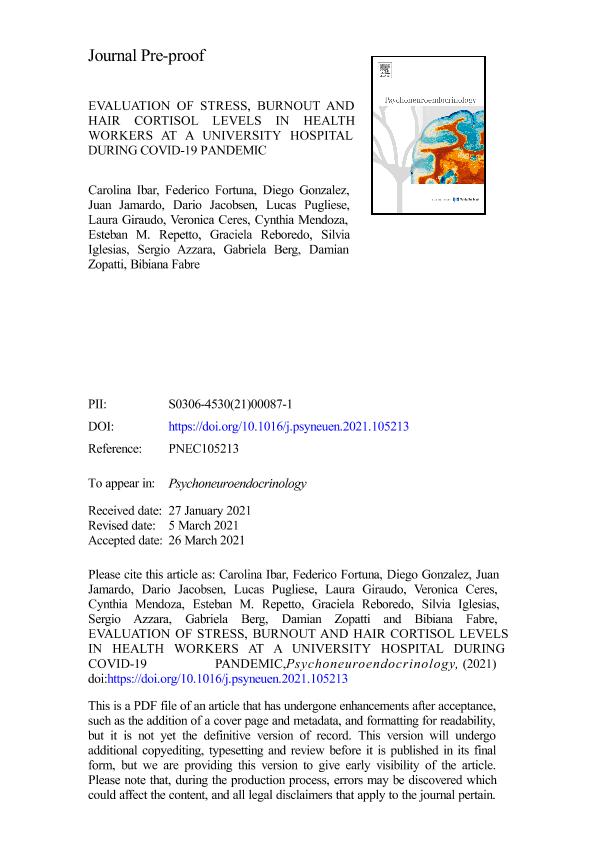Artículo
Evaluation of stress, burnout and hair cortisol levels in health workers at a University Hospital during COVID-19 pandemic
Ibar, Carolina; Fortuna, Federico; Gonzalez, Diego; Jamardo, Juan; Jacobsen, Dario; Pugliese, Lucas; Giraudo, Laura; Ceres, Veronica; Mendoza, Cynthia; Repetto, Esteban Martín ; Reboredo, Graciela; Iglesias, Silvia; Azzara, Sergio; Berg, Gabriela Alicia
; Reboredo, Graciela; Iglesias, Silvia; Azzara, Sergio; Berg, Gabriela Alicia ; Zopatti, Damian; Fabre, Bibiana
; Zopatti, Damian; Fabre, Bibiana
 ; Reboredo, Graciela; Iglesias, Silvia; Azzara, Sergio; Berg, Gabriela Alicia
; Reboredo, Graciela; Iglesias, Silvia; Azzara, Sergio; Berg, Gabriela Alicia ; Zopatti, Damian; Fabre, Bibiana
; Zopatti, Damian; Fabre, Bibiana
Fecha de publicación:
04/2021
Editorial:
Pergamon-Elsevier Science Ltd
Revista:
Psychoneuroendocrinology
ISSN:
0306-4530
Idioma:
Inglés
Tipo de recurso:
Artículo publicado
Clasificación temática:
Resumen
In the critical context of COVID-19 pandemic, healthcare workers are on the front line, participating directly in the care, diagnosis, and treatment of patients with COVID-19. This exposes them to a higher risk of developing chronic stress, psychological distress, and any other mental health symptoms. Objective: to evaluate stress and burnout in a health workers population and, in addition, to measure hair cortisol concentration as a current biomarker of stress. Materials and methods: 234 health workers from Hospital de Clínicas “José de San Martín”, Buenos Aires University, were included in this study. In this population hair samples were obtained from the posterior vertex as close to the scalp as possible and the individuals completed the following surveys: perceived stress, social support, burnout scale, life event scale, and sociodemographic data. Hair cortisol was measured by an automated chemiluminescent method. The studied population was divided into three groups considering those individuals below the healthy reference sample range (< 40 pg/mg hair), within the healthy reference range (40–128 pg/mg hair) and above the reference range (> 128 pg/mg hair). This study used a transversal and observational design. Results: Our results show that 40% of the studied population presented hair cortisol values outside of the healthy reference range. In the whole studied population, a direct correlation was found between hair cortisol concentration and perceived stress as well as between hair cortisol concentration and the emotional exhaustion component of burnout (r = 0.142, p = 0.030; r = 0.143, p = 0.029, respectively). 12% of the studied population showed Burnout (52% doctors and residents, 19% nurses, 19% administrative personnel). Higher values in hair cortisol levels were found in the group with burnout versus individuals without burnout (p = 0.034). Finally, a mediation analysis was performed, finding that depersonalization is a mediating variable in the relationship between self-perceived stress and hair cortisol level (F = 4.86, p = 0.0086; indirect effect IC: 0.0987-1.8840). Conclusion: This is the first study in which a stress biomarker such as hair cortisol is evaluated in this population and in this context. Healthcare workers are subjected to increased levels of stress and burnout. High depersonalization, emotional exhaustion, and decreased personal sense of accomplishment characterize this population. It is the responsibility of the health authorities to implement strategies to manage this psychological emergency.
Palabras clave:
BURNOUT
,
COVID-19
,
HAIR CORTISOL
,
HEALTHCARE WORKERS
,
STRESS
Archivos asociados
Licencia
Identificadores
Colecciones
Articulos(OCA HOUSSAY)
Articulos de OFICINA DE COORDINACION ADMINISTRATIVA HOUSSAY
Articulos de OFICINA DE COORDINACION ADMINISTRATIVA HOUSSAY
Citación
Ibar, Carolina; Fortuna, Federico; Gonzalez, Diego; Jamardo, Juan; Jacobsen, Dario; et al.; Evaluation of stress, burnout and hair cortisol levels in health workers at a University Hospital during COVID-19 pandemic; Pergamon-Elsevier Science Ltd; Psychoneuroendocrinology; 128; 4-2021; 1-27
Compartir
Altmétricas



